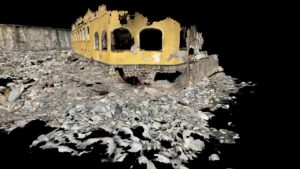In recent months, Cittadellarte has hosted two artistic residencies involving Theresa Schubert and Joshua G. Stein, artists who were selected through an open call curated by UNIDEE Residency Programs within the project S+T+ARTS4Water (2021-2022), part of the S+T+ARTS ecosystem, an initiative of the European Commission promoted within the framework of the research and innovation programme Horizon 2020 to support interdisciplinary collaborations between art, science and technology. The two artists investigated two different regional challenges identified by a team of local experts and researchers, both focusing on water resources and on a sustainable use of water in relation to the Sustainable Development Goals of the UN 2030 Agenda. The two projects went through phases of research, development and production with a view to the final presentation in the context of this year’s edition of Arte al Centro, which will open at Cittadellarte on 1 July 2022.
Rebuilding Relationships with Fluvial Systems: Exploring people’s relationships with rivers and streams is the regional challenge Joshua G. Stein has been engaged with during these months of research. He developed the project “Sediment as Cultural Heritage,” an investigation of how sediment – saturated with the positive and negative aspects of human development – can be conceived as part of the cultural heritage of an area. Sediment mobilized by waterways in the area becomes the common medium for conceptualising a vast system that operates on a territorial scale both spatially and temporally.

The very beginning of his research saw the artist taking part in meetings and field visits with various experts, which allowed him to gain a clear and concrete vision of the context of reference and of how to articulate his work, focusing on the link between industry, agriculture and water infrastructure in the western Po Valley.
The artist met with Nicolò Polidori for a tour of La Bessa Special Reserve: Nicolò introduced him to the area, its hydrology, geology and soil chemistry, in a visit that provided Joshua with an overview of the region’s topography and of the relationship between the morphology of mounds, ridges and basins sculpted by glacial movements and human operations. He then visited the Santuario di Oropa, a place closely related to his project proposal as a cultural element included in the network of the Sacred Mountains of Piedmont and a UNESCO World Heritage Site. Thanks to the assistance of Danilo Craveia, he was able to learn more about the history of the construction of the Santuario and of the chapels of the Sacred Mountains.
Together with local expert and artist Annalisa Zegna, Joshua then visited several locations along the River Cervo and the River Sesia, exploring the most interesting spots from a geological, geomorphological, historical and hydrographic point of view. He was also able to read up on the legacy of Biella’s textile industry at the DocBi Biellese Studies Centre archive at the Fabbrica della Ruota in Pray. Here, he met with Danilo Craveia, the archivist in charge of many historical archives in the Biellese region and an expert in documents relating to the various uses of water from historical and cultural perspectives. Joshua also met with Enrico Rivella, from the Northwest Department of Arpa Piemonte, who gave him the opportunity to investigate the artificial canal system for irrigation and how water is used in Vercelli’s rice fields. Another useful visit was to the CORDAR treatment plant in Cossato, where he was able to investigate the aerobic and anaerobic processes of its waste water purification system.
Joshua had then the opportunity to talk with experts and researchers from Turin’s Polytechnic and the University of Turin, who presented their projects on water and river systems in relation to their specific discipline, such as hydraulic engineering, water management in land and urban planning, and climate change prediction models. An important part of the meeting was devoted to the topic of technology in different research institutions, which provided the artist with suggestions on the tools and software which would be most useful in the development of his project. In the Piedmontese capital, the artist met with, among others, Professor Luca Ridolfi, a hydrological engineer from Turin’s Polytechnic; Enrico Rivella, a biologist and technical specialist from Arpa; and Manuela Lasagna and Giovanna Antonella Dino, researchers from the Department of Sedimentology of the Faculty of Earth Sciences at the University of Turin.
An important technological input for the development of the project was provided by Fabio Giulio Tonolo, Associate Professor of Geomatics at Turin’s Polytechnic. Through LiDAR technology, Joshua collected data on the natural and artificial conditions within the Oropa and Cervo river basin. The artist pointed out how, as it flows downhill, the River Oropa is channelled by infrastructure and architecture, and therefore interacts more directly with human habitation and industry, also becoming an informal dumping ground, as he discovered evidence of garbage bags being thrown into the stream. This set of data was important for Joshua to field test different types of pollution related to cultural heritage.
On 12 April, Joshua was also one of the guests at the first of the “Archipelago Talks”, an initiative held at Cittadellarte on the theme of water that featured twelve speakers from different organizations. The conference was proposed in collaboration with the project S+T+ARTS4Water as part of the initiatives of TACT, the winning project of the 3rd edition of the Creative Living Lab call promoted by the Ministry of Cultural Heritage – General Directorate for Contemporary Creativity.


